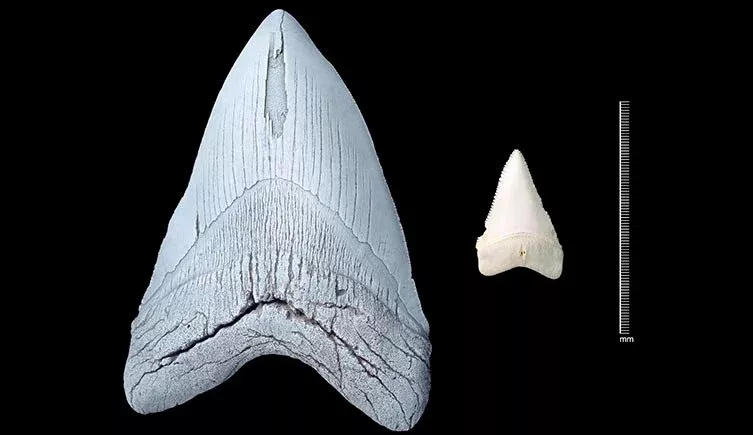Researchers used the teeth of 13 megalodon sharks and 20 modern great white sharks to analyze dietary signatures and their trophic levels or where they fit in the food chain. (Pictured: a megalodon tooth on the left next to a great white shark tooth on the right) The Natural History Museum, London
2Megalodon was a colossal species of mackerel shark that stalked the oceans 3.6 to 23 million years ago. The shark had a mouth the size of a subway door, teeth the size of a human palm, and could grow more than 50 feet long. Despite this, the fierce predators eventually vanished. Why they went extinct is still hotly debated among researchers, reports Veronique Greenwood for the New York Times. A paper published this week in Nature Communications suggests that the megalodon may have vanished because of great white sharks.
Both shark species coexisted during the Pliocene Epoch, about 2.6 to 5.3 million years ago, and may have hunted some of the same prey. The competition between both species could have been one reason why the megalodon went extinct. A predator does not have to be the largest to dominate an ecosystem, and great whites—which grow up to 20 feet long—may have outcompeted megalodons for prey. "Our new study shows that the dietary range of the early Pliocene great white shark is very similar to that of megalodon, indicating that our data do not contradict the competition hypothesis," Kenshu Shimada, study author and paleobiologist from DePaul University, says to CNN's Katie Hunt.
Researchers used the teeth of 13 megalodon sharks and 20 modern sharks to analyze dietary signatures and their trophic levels, which refers to where the animals fit in the food chain, CNN reports. The team looked for isotopes of zinc preserved in the enamel of each tooth. Heavier isotopes of zinc are common in plants, and therefore in herbivores, which tend to be lower on the food chain. Higher up the food chain, where carnivores tend to be, lighter zinc is more common.
Previous studies have shown that lighter zinc isotopes are found in present-day animals higher up in the food chain, the New York Times reports. This study is the first time that zinc isotopes related to diet were shown in fossilized shark teeth. Using their data, the team found that the trophic levels of great white sharks and megalodons overlapped, meaning there was likely some competition between the two species, reports Isaac Schultz for Gizmodo.
"Like great whites today, they likely fed on large fish. The smaller-sized great whites likely did not require as much food as megalodon did, so they would have had the competitive advantage if they were feeding on similar prey items," Michael Griffiths, study co-author and geochemist at the William Paterson University, told CNN.
However, the team also notes that other factors like climate change and the collapse of prey populations could have caused the megalodon to go extinct. The giant sharks could simply have starved in a changing world during the early Pliocene period, Gizmodo reports.




